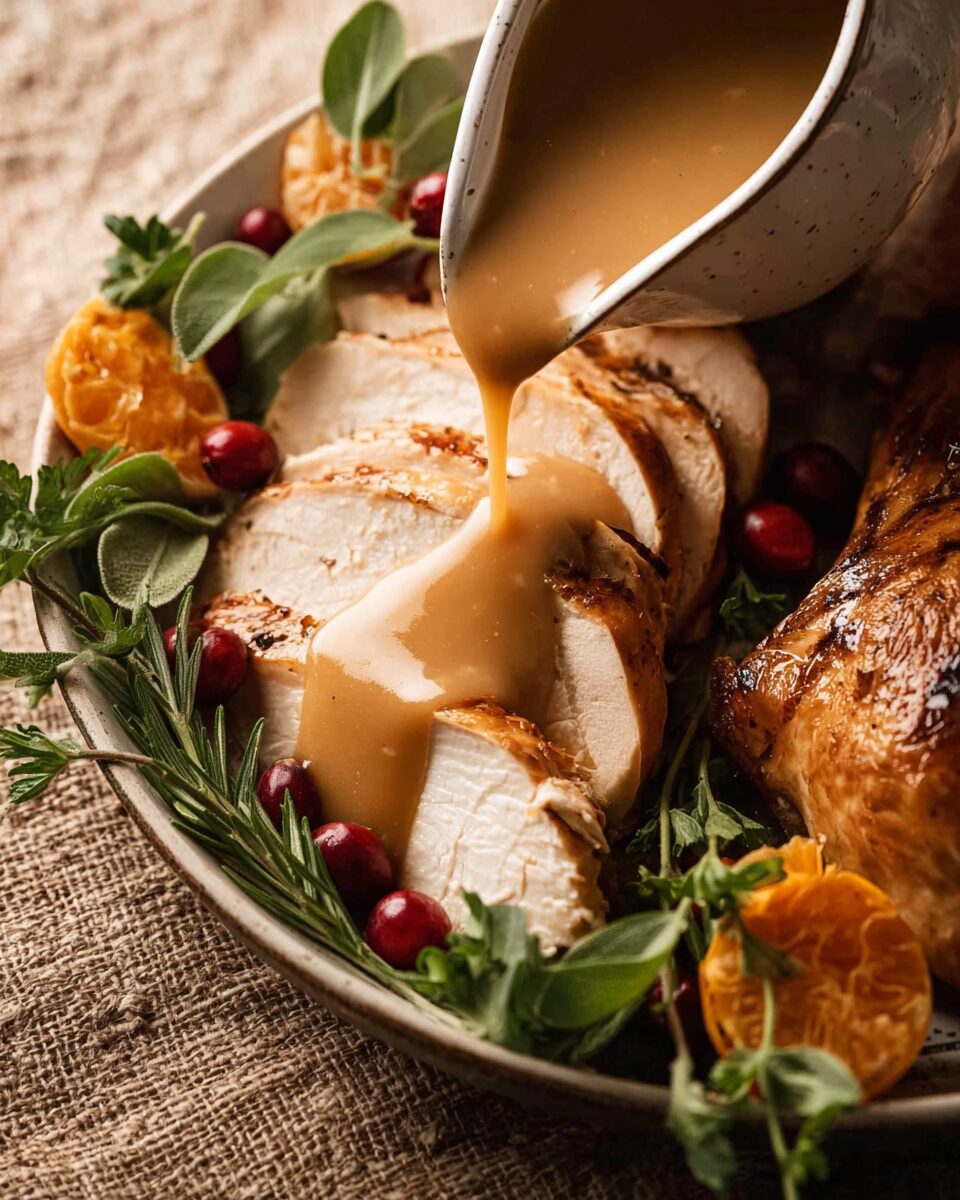Turkey gravy is the ultimate comfort food, bringing richness and warmth to any meal, especially during the holidays. Its silky smooth texture and deep, savory flavors enhance everything from mashed potatoes to roasted vegetables, making it the perfect companion for your Thanksgiving turkey.
This recipe ensures a gravy that’s packed with flavor, with just the right balance of butter and broth. Whether you’re serving it over mashed potatoes or alongside the star of your holiday table, it’s sure to be a crowd-pleaser. The fresh thyme adds a touch of herbaceous elegance, but feel free to adjust the seasonings to suit your taste. This turkey gravy is all about simplicity and perfection!
Full Recipe:
-
4 cups turkey drippings (from roasted turkey)
-
2 tablespoons butter
-
2 tablespoons all-purpose flour
-
2 cups turkey or chicken broth
-
Salt and pepper to taste
-
Fresh thyme (optional)
Directions:
-
After roasting the turkey, remove the turkey from the roasting pan. Pour the drippings into a fat separator or a bowl and set aside.
-
In a medium saucepan, melt the butter over medium heat.
-
Whisk in the flour to create a roux, stirring constantly for about 2-3 minutes, until the mixture is golden brown.
-
Gradually add the turkey drippings and turkey (or chicken) broth, whisking constantly to avoid lumps.
-
Bring the mixture to a simmer and cook, whisking frequently, for about 5-10 minutes, until the gravy has thickened to your desired consistency.
-
Season with salt and pepper to taste. Add fresh thyme if using.
-
Serve the turkey gravy hot over roasted turkey and mashed potatoes.
Prep Time: 5 minutes | Cooking Time: 10 minutes | Total Time: 15 minutes
Kcal: 60 kcal | Servings: 8 servings
The Origins of Turkey Gravy
Turkey gravy is one of the most beloved accompaniments to a Thanksgiving or holiday meal, providing a rich, savory element that perfectly complements the tenderness of the roasted bird. Its roots trace back to ancient cooking traditions, where the goal was to enhance the flavor of meat using its own drippings. In many cultures, the idea of making a sauce from the juices of roasted meats became a key element of celebratory feasts. For turkey gravy, specifically, this practice evolved as turkey became the centerpiece of holiday meals, especially in North America. The process of making turkey gravy, while simple, is an essential culinary skill passed down through generations. It takes just a few ingredients and a little patience to create a velvety, flavorful sauce that can elevate any meal.
Why Turkey Gravy is a Must-Have for the Holidays
Turkey gravy is the ultimate comfort food that adds an undeniable richness to your meal. Its smooth and velvety texture is the perfect complement to the dry or lean texture of roasted turkey, helping balance out the flavors on the plate. The drippings from the turkey are a concentrated source of flavor, and when combined with a roux (a mixture of butter and flour) and broth, they create a sauce that has a deep, savory profile. This combination transforms your holiday meal into something extraordinary.
Not only does gravy add flavor, but it also brings warmth and a sense of indulgence. The moment you pour gravy over mashed potatoes or stuffing, you create a harmonious blend of flavors that enhances the entire meal. It’s not just a topping—it’s a crucial component that ties together all the elements of the plate, bringing everything into one delicious, comforting experience.
Making the Perfect Turkey Gravy
To make turkey gravy, the key is in balancing the flavors of the turkey drippings, butter, flour, and broth. The turkey drippings are where all the flavor lies, so it’s essential not to waste them. They have absorbed all the juices from the bird, creating a flavorful base for your gravy. The addition of butter and flour to create a roux ensures that the gravy will have a thick, smooth consistency, while the broth adds volume and richness.
Many home cooks face challenges when making gravy, especially in getting the right texture and flavor. Some may struggle with lumps, while others might end up with a gravy that’s too thin or too thick. The secret to perfect turkey gravy lies in your technique and the patience you apply when making it. By slowly adding the drippings and broth to the roux, whisking constantly, you avoid any lumps and achieve the desired consistency.
Tips for the Best Turkey Gravy
While the basics of turkey gravy are simple, there are several tips that can help you elevate it to the next level:
-
Use Good Quality Drippings: The flavor of your gravy is only as good as the turkey drippings you use. Be sure to save all the juices from the roasting pan after the turkey is cooked. Strain the fat from the drippings to avoid any greasy texture in your gravy.
-
Adjust the Consistency: If your gravy is too thick, simply add more broth until you reach your desired consistency. If it’s too thin, continue simmering it to thicken. Gradually adjusting helps you avoid over-thickening the gravy.
-
Seasoning is Key: Always taste your gravy before serving. Depending on the richness of the turkey drippings, you may need to add salt and pepper to achieve the right seasoning. A pinch of fresh herbs like thyme or rosemary can also bring extra depth of flavor.
-
Don’t Forget the Roux: A roux is essential for thickening the gravy without making it lumpy. Cook it gently to avoid burning, and be sure to whisk constantly as you add the liquids.
-
Keep it Warm: Turkey gravy should be served warm, so keep it on a low simmer until you’re ready to serve. If it cools down, it will thicken too much, and you might need to add more liquid to loosen it up.
Different Variations of Turkey Gravy
While the traditional turkey gravy recipe is beloved by many, there are a few variations that can offer unique twists to this classic sauce. Here are some ideas to help you experiment with turkey gravy:
-
Herbed Turkey Gravy: Adding fresh herbs like thyme, rosemary, sage, or bay leaves can infuse your gravy with even more aromatic flavors. Simply add the herbs to the gravy while it simmers to release their essence, then strain them out before serving.
-
Mushroom Turkey Gravy: For a more earthy flavor, sauté some mushrooms in butter before adding them to your turkey gravy. The mushrooms bring an additional depth of flavor and a bit of texture to the sauce.
-
Cranberry Turkey Gravy: If you love cranberry sauce with your turkey, try incorporating a bit of cranberry into your gravy for a sweet and tart contrast to the savory richness. A tablespoon of cranberry sauce stirred into your gravy can add a surprising twist.
-
Smoky Turkey Gravy: To add a smoky flavor to your gravy, consider incorporating a dash of smoked paprika or even a few drops of liquid smoke. This gives your gravy a slightly different edge, perfect for those who enjoy more robust, smoky flavors.
-
Spicy Turkey Gravy: For those who love heat, adding a small amount of chili powder, cayenne pepper, or red pepper flakes can add a spicy kick to the gravy. Just be sure to taste as you go, as it’s easy to make it too spicy.
Gravy Pairings: What to Serve with Turkey Gravy
Turkey gravy is a versatile sauce that can be paired with many dishes beyond just turkey. Here are some ideas for what you can serve your homemade gravy with:
-
Mashed Potatoes: This classic pairing is a no-brainer. The creamy potatoes absorb the rich gravy beautifully, creating the perfect side dish.
-
Stuffing: Gravy is often served alongside stuffing or dressing, adding flavor and moisture to this traditionally dry dish.
-
Roasted Vegetables: Turkey gravy also complements roasted vegetables like carrots, Brussels sprouts, and parsnips. The earthy flavors of the veggies pair well with the richness of the gravy.
-
Biscuits or Rolls: If you’re serving biscuits or rolls, turkey gravy is a great dipping sauce. The buttery, flaky texture of the bread pairs wonderfully with the thick gravy.
Conclusion
In the end, turkey gravy is more than just a sauce—it’s an essential part of the holiday meal that brings everything together. The process of making gravy may be simple, but it’s an important skill that can make your holiday meal feel even more special. Whether you follow the traditional recipe or experiment with new variations, the result will always be a rich and comforting addition to your table.
As you prepare your turkey gravy this holiday season, remember to take your time, adjust the seasoning as needed, and enjoy the process. It’s the little touches that elevate a meal, and the perfect gravy can turn a good holiday dinner into a truly memorable one. So next time you roast a turkey, don’t forget to save those drippings, whisk up that roux, and make a batch of turkey gravy that will leave your guests coming back for seconds!





